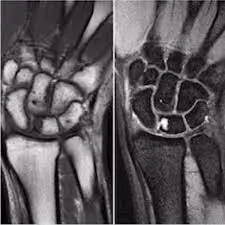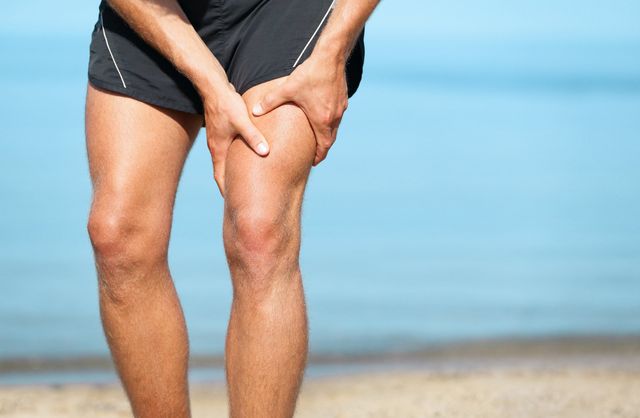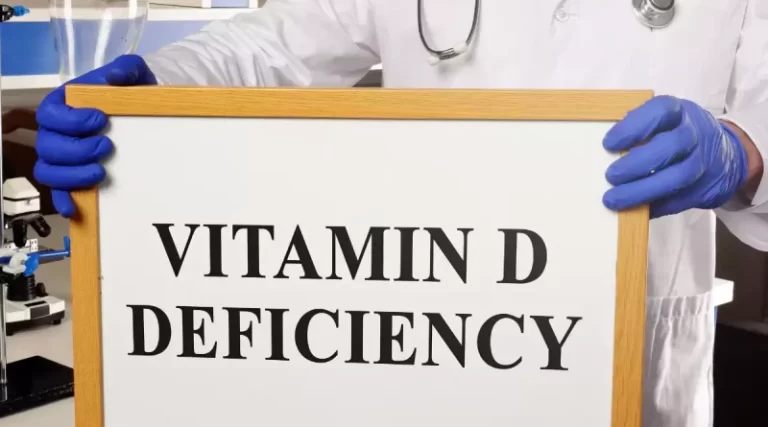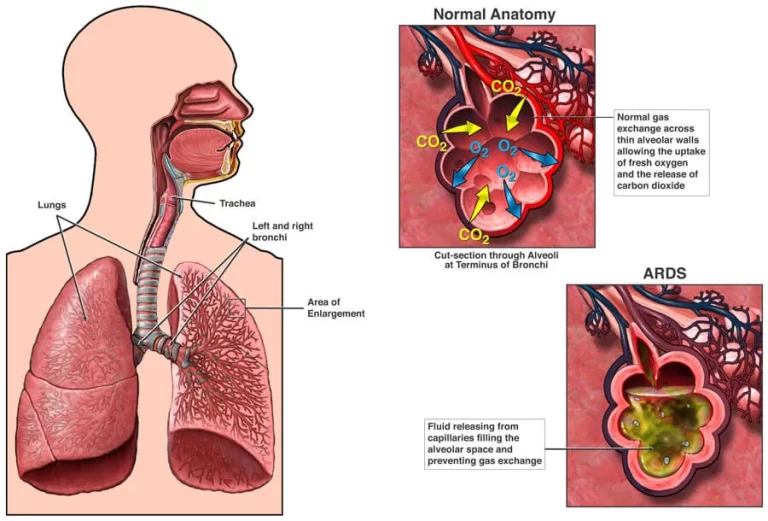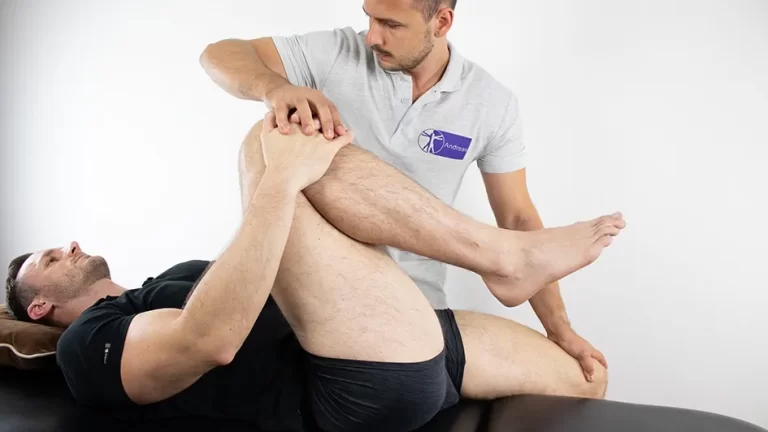Intraosseous Ganglion Cyst of Lunate Bone
Table of Contents
What is an Intraosseous Ganglion Cyst of the Lunate Bone?
An intraosseous ganglion cyst of the lunate bone, also known as a lunate bone ganglion, is a rare benign cystic lesion that forms within the lunate bone of the wrist. The lunate bone is one of the eight carpal bones in the wrist and is an important part of the wrist joint.
Description
Intraosseous: This refers to something that is inside a bone.
Ganglion cyst: A ganglion cyst is a fluid sac or lump that usually develops near joints or tendons. These cysts are usually not cancerous and are filled with thick gelatinous fluid.
Lunate Bone: The lunate is one of the eight small bones that make up the wrist joint. It is located on the inside of the wrist, between the radius and hand bones.
An intraosseous ganglion cyst occurs when a ganglion cyst forms in the bone. The exact cause of these cysts is not always clear, but they are often related to repetitive stress or microtrauma to the wrist joint. As a result, a cyst forms inside the bone as a small sac filled with fluid.
A cyst can put pressure on surrounding structures, including nearby bones, ligaments, and nerves. This can cause pain, stiffness, weakness, or limited movement in the wrist joint. Depending on the size and location of the cyst, the pain can range from mild discomfort to more severe.
Anatomy of an interosseous ganglion cyst of lunate
The anatomy of an intraosseous ganglion cyst involves the carpal joint and the carpal bone itself. To get a clearer picture, we briefly describe the relevant anatomy:
Carpal Joint:
- The wrist joint is a complex structure that connects the bones of the forearm (radius and ulna) to the bones of the hand (carpal and metacarpal).
- It allows a wide range of motion, including flexion, extension, adduction, and abduction.
Carpal bone:
- The carpal bone consists of eight small bones located in the wrist.
- They are arranged in two rows (proximal and distal) and play an essential role in the stability and movement of the wrist.
- The bone is one of the eight carpal bones.
Lunate:
- a moon-shaped carpal bone located on the inner (medial) side of the carpal joint, between the radius and the other carpal bones.
- It is part of the wrist joint with the radius of the forearm.
- Now we relate this to the intraosseous ganglion cyst condition:
- When someone develops an intraosseous ganglion cyst, it means that a ganglion cyst has formed inside the bone.
- Rather than developing outside the bone or into the surrounding soft tissue (as is more common with ganglion cysts), this cyst formed within the bone itself.
- As with other ganglion cysts, the cause of an intraosseous ganglion cyst is not always well understood but is often caused by repetitive stress or microtrauma to the wrist joint.
- A cyst develops as a fluid-filled sac inside a bone that can put pressure on surrounding structures, causing pain, stiffness, weakness, or limited movement in the wrist joint.
Epidemiology
specific epidemiologic data on intraosseous ganglion cysts were not readily available. Ganglion cysts are usually relatively common and can occur anywhere in the body. However, data on the incidence and prevalence of lunate intraosseous ganglion cysts have not been widely reported in the medical literature.
Ganglion cysts are more common in certain populations, such as:
- Age: They are more common in people between the ages of 20 and 40, although they can develop at any age.
- Gender: Ganglion cysts are more common in women than in men.
- Occupation and activities: Certain occupations or activities that involve repetitive strain on the wrist or hand may increase the risk of developing ganglion cysts, although this has not been specifically studied for intraosseous ganglion cysts.
- Previous injuries: People with a history of wrist injuries or injuries may be more likely to develop a ganglion cyst.
It is important to remember that medical research and information may have evolved since the last update in 2021, and more recent studies may have examined the epidemiology of intraosseous ganglion cysts. For the most up-to-date and accurate information on the epidemiology of this condition, it would be best to consult the latest medical literature or consult with health professionals who specialize in hand and wrist diseases.
Causes of Intraosseous Ganglion Cyst of Lunate Bone
The exact cause of an intraosseous ganglion cyst is not always well understood and can vary from person to person. However, several factors are generally associated with the development of ganglion cysts, including bone cysts.
Some causes are:
Osteoarthritis:
Ganglion cysts are thought to be associated with osteoarthritis. Over time, wear and tear on the wrist joint can weaken the bone or connective tissues surrounding the joint.
Accumulation of synovial fluid:
A cyst forms when the synovial fluid that normally lubricates the joint leaks into the surrounding tissue or bone through weak areas in the joint capsule or other structures.
Repetitive stress:
Repetitive movements or activities that put too much stress on the wrist joint can contribute to the development of a ganglion cyst. Occupations or hobbies that involve frequent wrist movements may increase the risk.
Microtrauma:
Small injuries or microtrauma to the wrist joint can damage the joint structures, which can lead to the formation of a ganglion cyst.
Past injuries:
Past injuries to the wrist, such as fractures or sprains, can be a risk factor for an intraosseous ganglion cyst.
Gender and age:
As mentioned earlier, ganglion cysts are more common in women and often occur in people between the ages of 20 and 40.
Genetic predisposition:
There may be a genetic component that makes some people more prone to developing ganglion cysts.
- It is important to note that although these factors may increase the likelihood of an intraosseous ganglion cyst, the exact mechanism of cyst formation may not be fully understood in every case.
- Additionally, not everyone with these risk factors can develop a ganglion cyst.
- If you suspect a ganglion cyst or experience pain or discomfort in your wrist, it is important to seek evaluation and diagnosis from a qualified physician, such as an orthopedist or hand surgeon.
- They can properly evaluate your condition, recommend appropriate imaging tests, and determine the most appropriate treatment plan for your particular case.
Symptoms of Intraosseous Ganglion Cyst of Lunate Bone
An intraosseous ganglion cyst can cause a variety of symptoms that can range in severity from mild to severe. The appearance and intensity of symptoms often depend on the size and location of the cyst in the ear and its effect on surrounding structures. Common symptoms of a lunate intraosseous ganglion cyst may include:
Wrist pain:
Constant or intermittent pain in the wrist is a common symptom. The pain can be localized in the area of the cyst or radiate to the surrounding wrist and hand.
Swelling:
There may be significant swelling in the affected area, which may feel soft or spongy to the touch.
Limited range of motion:
A cyst can interfere with the normal movement of the wrist, resulting in a reduced range of motion. This limitation can affect daily activities, especially those that require wrist flexibility.
Weakness and instability:
a cyst can weaken the wrist joint and cause a feeling of instability, making it difficult to grasp or perform specific tasks.
Stiffness:
The wrist may feel stiff, especially after periods of inactivity or rest. Tenderness: The area around the cyst may be tender or tender to pressure.
Numbness or tingling:
In some cases, pressure from the cyst on nearby nerves can cause numbness, tingling, or a “pins and needles” sensation in the hand or fingers.
- It is important to note that not all lunate intraosseous ganglion cysts cause noticeable symptoms, and some people may be asymptomatic or experience only mild discomfort.
- In such cases, the cyst may be accidentally discovered during medical imaging to detect unrelated problems.
- If you have any of these symptoms or are concerned about your wrist, it is important to seek an evaluation and diagnosis from a qualified physician, such as an orthopedist or hand surgeon.
- Correct diagnosis and timely treatment help control symptoms and prevent possible complications.
- Treatment options may include observation, conservative measures, aspiration, or surgical intervention, depending on the size, location, and impact of the cyst on wrist function.
Complications
If left untreated or untreated, intrauterine ganglion cysts can cause a number of complications. It is important to treat these cysts quickly to avoid long-term problems. Some possible complications include:
Increased pain and discomfort:
- As the cyst enlarges or presses on more surrounding structures, it can increase pain and discomfort in the wrist joint.
- This pain can become chronic and interfere with daily activities.
Limited range of motion:
- As the cyst affects the range of motion of the wrist joint, it can cause a limited range of motion.
- This limitation can interfere with daily tasks and impair hand function.
Weakness and instability:
- A lunate ganglion cyst can weaken the integrity of the wrist joint, causing a feeling of instability.
- This instability can impair grip strength and hand coordination.
Nerve compression:
- In some cases, a cyst can compress nearby nerves, causing symptoms such as numbness, tingling, or weakness in the hand or fingers.
Risk of fracture:
- In rare cases, a large or enlarging ganglion cyst within the patella can compromise the structural integrity of the bone, increasing the risk of fractures or other injuries in the affected area.
Cyst Rupture:
Although rare, a ganglion cyst can rupture, releasing its contents into the surrounding tissues. This can cause inflammation and pain.
Recurrence:
Even after treatment or removal, cysts can recur, especially if the cause is not adequately treated or if surgical excision is incomplete.
- It is very important to see your doctor if you suspect you have a ganglion cyst or if you have pain or discomfort in your wrist.
- A qualified healthcare professional, such as an orthopedist or hand surgeon, can make the correct diagnosis, assess the size and location of the cyst and recommend the most appropriate treatment method.
- Early intervention helps to avoid possible complications and improve the outcome.
- Treatment options may include observation, conservative treatment, aspiration, or surgical removal, depending on the characteristics and severity of the individual case.
Diagnosis
Diagnosis of an intraosseous ganglion cyst usually involves a combination of a complete medical history, physical examination, and imaging studies. A qualified healthcare professional, such as an orthopedic specialist or hand surgeon, performs these evaluations to determine the presence and characteristics of a cyst.
The diagnostic process is:
Medical history:
- Your doctor will first ask about your symptoms, including the location, duration, and intensity of wrist pain, swelling, or other discomfort.
- They will also ask about any previous wrist injuries or conditions that may be serious.
Physical exam:
- During a physical exam, a healthcare professional will examine your wrist and hand and look for signs of swelling, tenderness, or changes in range of motion.
- They also assess grip strength and overall wrist function.
Imaging studies:
Visualize the cyst and confirm its presence and location, the doctor may order imaging studies, such as:
a. X-rays: X-rays can help assess the overall structure of the bones in the wrist and reveal any bone changes or joint degeneration associated with the cyst.
b) Magnetic Resonance Imaging (MRI): MRI provides detailed images of soft tissues including the cyst, tendons, ligaments, and nerves. It can help determine the cyst’s size, location, and extent within the lunate bone.
c. Computed Tomography (CT): In some cases, a CT scan may be ordered to more accurately evaluate the cyst and surrounding bony structures.
Differential diagnosis
When evaluating a patient with a suspected intraosseous ganglion cyst, healthcare professionals consider several possible conditions in the differential diagnosis. These conditions may have similar symptoms or radiological findings, so it is essential to differentiate them for proper management. Some differential diagnoses include:
Intra-articular ganglion cyst:
A ganglion cyst originates in the joint capsule or synovium and extends into the joint space. This type of ganglion cyst can cause symptoms similar to a lunate intraosseous ganglion cyst.
Lunatomalacia:
Also known as Kienböck’s disease, this is a condition in which blood flow to the bone is reduced, leading to bone death (vascular necrosis). This can cause pain, swelling, and limited movement in the wrist.
Fracture of the Scaphoid:
Fracture of the Scaphoid, which is the second carpal bone near the lunate. Scaphoid fractures can cause pain and swelling in the wrist, and special imaging may be necessary to make an accurate diagnosis.
Osteoarthritis:
Osteoarthritis of the wrist can cause joint pain, swelling, stiffness, and decreased wrist function, which may overlap with the symptoms of an intraosseous ganglion cyst.
Rheumatoid arthritis:
An autoimmune disease that can affect several joints, including the wrist. Rheumatoid arthritis can cause joint inflammation, pain, and deformity.
Tenosynovitis:
Inflammation of the tendon sheaths in the wrist can cause localized pain, swelling, and limited range of motion.
Tumors:
Rarely, bone tumors or cystic lesions may present with wrist pain and swelling that require further evaluation and imaging.
Joint injuries:
- Injury to the ligaments surrounding the wrist joint, such as the ligaments or lunotriquetral ligaments, can cause wrist pain and instability.
- An accurate diagnosis is critical to determining the most appropriate treatment plan.
Imaging studies such as X-rays, MRIs, and CT scans can help differentiate these conditions and identify the location and nature of the lesion, helping the doctor make an informed diagnosis. A thorough medical history, physical examination, and consultation with a specialist will help rule out other possible causes of wrist symptoms and provide the patient with the best possible treatment.
Medical treatment
Medical treatment for an intraosseous ganglion cyst usually depends on the size, location, and severity of symptoms. In some cases, conservative measures may be sufficient to control the cyst, while in other cases, more invasive measures may be necessary. Here are some treatment options:
Observation and monitoring:
- If a ganglion cyst is small, asymptomatic, and does not cause significant discomfort or functional limitations, the doctor may choose to monitor it over time.
- Regular follow-ups and imaging studies can help monitor changes in cyst size or symptoms.
Immobilization:
- Using a wrist splint or brace can help limit wrist movement and reduce pressure on the cyst.
- Immobilization is often used as a short-term treatment to relieve symptoms and promote healing.
Pain management:
- Over-the-counter pain relievers such as non-steroidal anti-inflammatory drugs (NSAIDs) may be recommended to relieve pain and inflammation associated with the cyst.
Aspiration (cyst aspiration):
- In some cases, the doctor may perform a procedure called aspiration to drain the fluid from the cyst with a needle.
- This procedure can provide temporary pain relief and reduce the size of the cyst.
- However, cyst aspiration has a higher chance of recurrence than surgical removal.
Corticosteroid injections:
- Corticosteroid injections into the cyst can help reduce inflammation and relieve pain.
- This treatment is usually considered when aspiration alone is not effective or when the cyst recurs after aspiration.
- It is important to note that treatment may provide temporary relief but may not treat the underlying cause of the cyst.
- If conservative measures fail to adequately control symptoms, or if the cyst causes significant pain and dysfunction, surgical intervention may be considered.
- Surgical excision involves removing the cyst and associated joint degeneration to prevent recurrence and relieve symptoms.
- Ultimately, the choice of treatment depends on the specific condition of the individual, the symptoms, and the judgment of the doctor.
- If you suspect that you have a lunate intraosseous ganglion cyst or have pain or discomfort in your wrist, it is important to seek an evaluation and diagnosis from a qualified healthcare professional, such as an orthopedist or hand surgeon.
- They can recommend the most appropriate treatment plan tailored to your specific case.
Physiotherapy treatment
Physiotherapy can play a valuable role in the treatment of menstrual intraseasonal ganglion cysts. Although physical therapy alone will not remove the cyst, it can help relieve symptoms, improve wrist function, and prevent further complications. Special physiotherapy treatment is adapted to individual needs, symptoms, and the impact of the cyst on wrist function. Below given are some common physical therapy procedures:
Pain management:
Physical therapists can use a variety of methods to relieve pain and reduce inflammation around the cyst, such as ice or heat therapy, ultrasound, or transcutaneous electrical nerve stimulation (TENS).
Range of motion exercises:
Gentle, controlled exercises may be prescribed to maintain or improve the wrist range of motion. These exercises help prevent stiffness and increase flexibility. Wrist range of motion exercises can help improve flexibility, reduce stiffness, and maintain wrist health. Here are some simple exercises to promote a full range of motion in your wrist:
Wrist flexor stretch:
- Extend the arm in front, palm up. With the other hand, gently pull the fingers back until you feel a stretch in the wrist and forearm.
- Maintain the stretch for 10-20 seconds and repeat with the other arm. Do 2-3 repetitions for each arm.
Wrist Stretch:
- Extend the arm in front, palm down.
- With your other hand, gently pull your fingers back until you feel a stretch in the back of your wrist and forearm.
- Maintain the stretch for 10-20 seconds and repeat with the other arm.
- Do 2-3 repetitions for each arm.
Wrist pronation and supination:
- Sit or stand with your arms at your sides and elbows at a 90-degree angle.
- Keep your palms facing the ground and then slowly rotate your arms outward so that your palms are facing up (supination).
- Then turn your hands inward so that the palms are facing down (prone).
- Do 10-15 repetitions in both directions.
Wrist circles:
- Hold your hand out in front of you, fingers up.
- Start with small circular movements with your wrist and gradually increase the size of the circles.
- After 5-10 seconds, reverse the direction of the movement.
- Do 2-3 sets in both directions.
Wrist flexion and extension:
- Sit or stand with your arms at your sides and elbows at a 90-degree angle.
- Bend your wrists up (flexion) and then down (extension), moving your arms toward the ceiling and floor.
- Do 10-15 repetitions of wrist flexion and extension.
- Remember to perform these exercises slowly and carefully, without movements.
- If you experience pain or discomfort during exercise, stop and speak to a doctor or qualified physiotherapist before continuing.
- Regular wrist exercises can help maintain wrist flexibility, reduce the risk of stiffness, and improve overall wrist function.
- However, if you have a wrist condition or injury, it is important to consult a doctor or physical therapist before beginning an exercise program to ensure that the exercises are appropriate for your needs.
Strengthening exercises:
Strengthening the muscles around the wrist joint can provide better support and stability. Physical therapists may use resistance training or progressive resistance training to target specific muscles in the forearm and hand. Wrist-strengthening exercises can help improve wrist stability, grip strength, and overall function. It is important to perform these exercises correctly and start with light resistance, gradually increasing it as your strength improves. Here are some effective wrist-strengthening exercises:
Wrist curls (flexion and extension):

- Sit in a chair or stand with your forearm resting on a flat surface (such as a table) and your palm facing up.
- Hold a light dumbbell or a household object (such as a soup can) in your hand.
- Slowly bend the wrist upwards, bringing the weight to the body (bending).
- Lower the weight back
- Do 10-15 repetitions for 2-3 sets.
- Repeat with the other hand.
Wrist deviation (radial and ulnar):
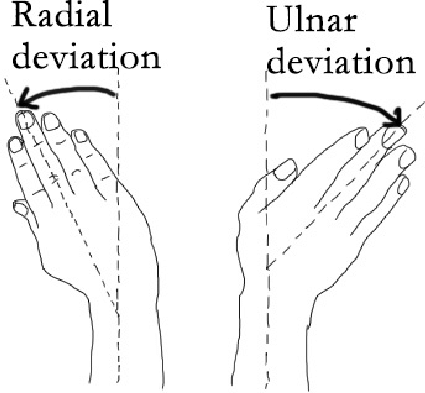
- Sit in a chair or stand with your forearm resting on a flat surface and your palm facing down.
- Hold a light stop or household item.
- Slowly bend the wrist to the thumb (radial deviation) and then to the pinky (ulnar deviation).
- Do 10-15 repetitions for 2-3 sets.
- Repeat with the other hand.
Grip Strengthening – Hand Exercise:
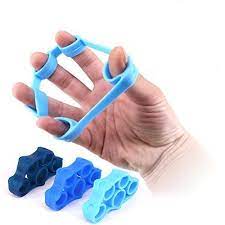
- Hold the grip in your hand with the palm facing up.
- Squeeze the handle, engaging the muscles in your hand and forearm.
- Hold the handle for a few seconds and then release it slowly.
- Do 10-15 repetitions in 2-3 sets.
- Repeat with the other hand.
Finger flexion exercise:
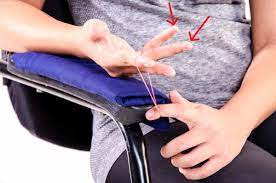
- Place your forearm on a flat surface with your palm facing down and your fingers extended.
- Place a rubber band or rubber band around your fingers.
- While squeezing the rubber band, slowly bend your fingers.
- Return your fingers to the starting position.
- Do 10-15 repetitions for 2-3 sets.
Wrist Roll Exercise:
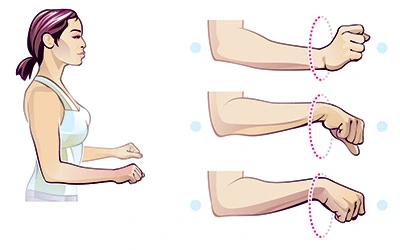
- Attach a lightweight to the end of a dowel or stick and secure it with string or twine.
- Hold the nail with both hands, palms down.
- Roll the weight by turning the needle with your wrists, bringing the weight towards you.
- Lower the weight by winding the needle back.
- Do 5-10 repetitions in 2-3 sets.
- Be sure to do these strengthening exercises under control and avoid overloading the wrist joints.
- If you feel pain or discomfort, reduce the resistance or stop the exercises and consult a doctor or qualified physical therapist.
- Also, if you have a wrist condition or injury, it’s important to get clearance from your healthcare practitioner before starting strength training.
Finger squeezes:
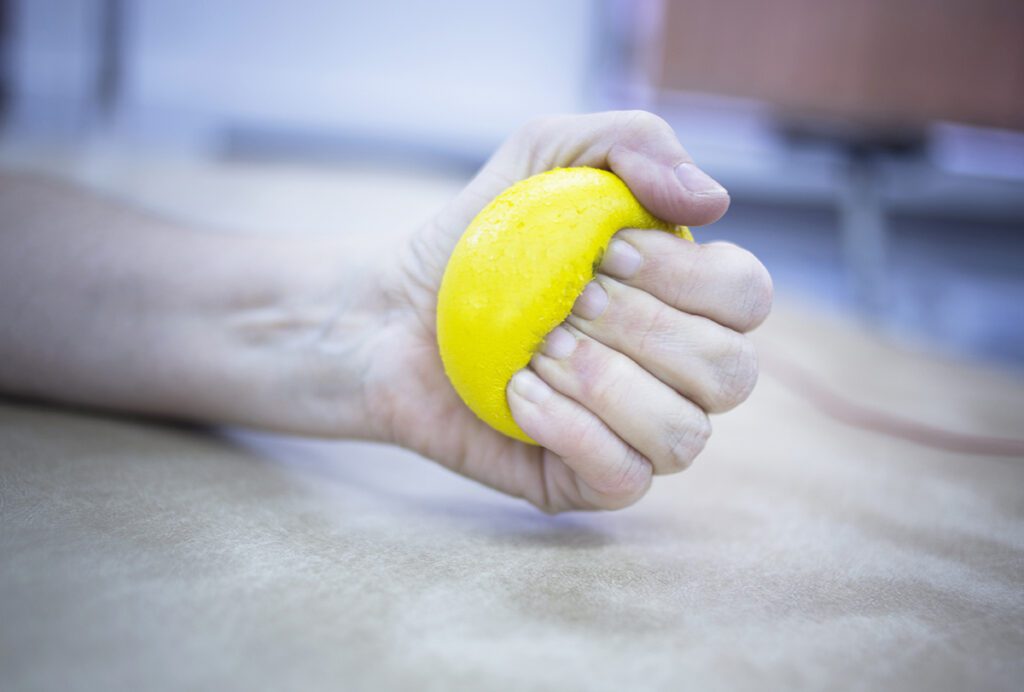
- Place a soft foam or rubber ball in the palm of your hand.
- Squeeze the ball as hard as you can with all your fingers.
- Maintain the pressure for 10-20 seconds
- then release.
- Repeat 10-15 times with each hand.
Finger extensions:
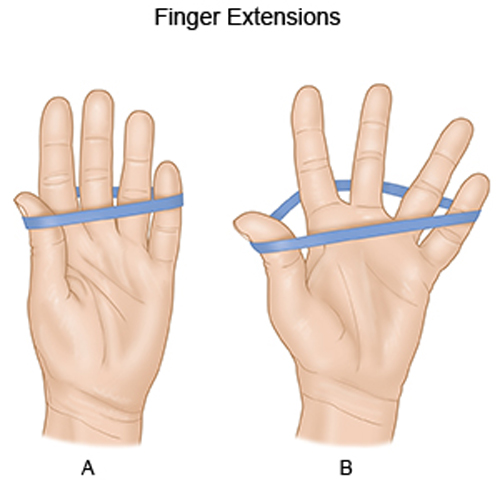
- Extend your fingers as far as possible.
- Maintain the position
- then relax.
- Repeat 10-15 times with each hand.
Thumb opposition:
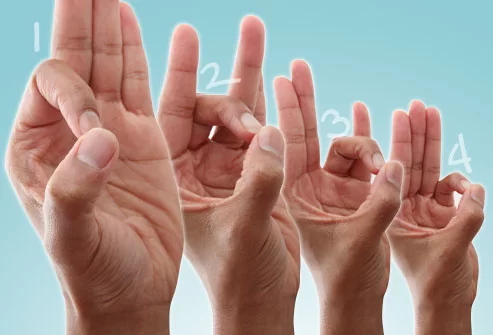
- Touch the tip of each finger one at a time with the tip of your thumb (make an O shape with your thumb and each finger).
- Repeat this set 10-15 times with each arm.
Hand grip exercise:
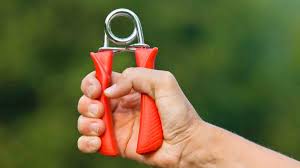
- Hold the grip in your hand with the palm facing up.
- Squeeze the handle, engaging the muscles in your hand and forearm.
- Hold the handle for a few seconds and then release it slowly.
- Do 10-15 repetitions for each arm.
Wrist extension with resistance:
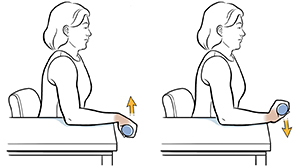
- Sit in a chair with your arm resting on your thigh, palm down.
- Muffle the resistance band around your fingers and thumb.
- Extend your wrist back, pulling the resistance against the strap.
- Return to the starting position with control.
- Do 10-15 repetitions for each arm.
Finger pinch:
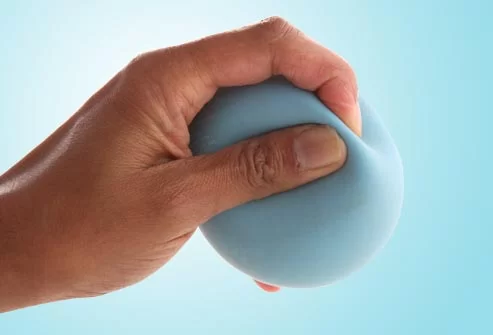
- Place a small object (such as a coin or a small ball) between the tips of your thumb and forefinger.
- Press your thumb and finger together to hold the target.
- Maintain for a few seconds
- then release.
- Repeat 10-15 times with each hand.
Tapping the table:
- Raise your arms flat on a table or platform.
- Raise each finger individually by tapping it against the table while keeping the others down.
- Repeat tapping with each finger one at a time.
- Do 10-15 repetitions for each finger with both hands.
Manual therapy:
Manual techniques such as soft tissue mobilization and joint mobilization can help reduce muscle tension and improve wrist joint mobility.
Taping and Splicing:
Taping or splicing your wrist in a particular position can reduce pain, support the joint and prevent excessive movement, which promotes healing.
Ergonomic advice:
Physiotherapists can advise on correct wrist and hand ergonomics during activity and work to avoid unnecessary stress on the wrist joint.
Activity modification:
In collaboration with the patient, the physical therapist may recommend certain activities that aggravate symptoms or increase the load on the wrist.
Education:
Education about the condition, lifestyle changes, and self-care techniques can empower a person to take an active role in their recovery and symptom management.
- It is important to remember that physical therapy is a conservative approach and may not be sufficient for large or symptomatic cysts.
- In such cases, the healthcare professional may consider other treatment options, such as aspiration or surgical excision.
- If you have an intraosseous ganglion cyst or have pain or discomfort in your wrist, contact a qualified physiotherapist or doctor.
- They can design a personalized physical therapy program that meets your specific needs and helps you effectively manage your condition.
Surgical methods
Surgical treatment of an intraosseous ganglion cyst may be considered if conservative measures have not provided adequate relief or if the cyst causes significant pain, dysfunction, or other complications. A number of surgical techniques can be used to treat a lunate intraosseous ganglion cyst. The choice of surgical approach depends on the size, location, and skill of the surgeon. Below given are some of the more common surgical procedures:
Curettage and bone grafting:
- In this procedure, the surgeon removes the cyst from the eardrum with a special device called a curette.
- After the cyst is excised, a bone graft can be used to fill the void left by the cyst.
- Bone grafts can be taken from other areas of the body or obtained from a bone bank.
- Transplantation promotes bone healing and reduces the risk of cyst repair.
Arthroscopic resection:
- Arthroscopic surgery involves making small incisions and using a thin, flexible tube with a camera (arthroscope) to visualize and remove the cyst.
- This minimally invasive approach can result in smaller incisions, less post-operative pain, and a faster recovery compared to open surgery.
Open surgical resection:
- Open surgery involves making a larger incision directly above the cyst to access and remove it.
- Open resection may be better for larger or more complex cysts because it allows better visualization and complete removal of the cyst.
Internal fixation:
- In some cases, when the cyst has caused structural damage to the ear, the surgeon may use internal fixation techniques.
- This requires the use of screws or plates to stabilize the bones and promote proper healing.
Lumbar surgery:
- In rare cases, if the eardrum is seriously damaged or if the cyst cannot be completely removed while preserving the integrity of the bone, the surgeon may decide to perform a bone resection.
- However, this procedure can cause wrist instability and reduced range of motion and is generally avoided if possible.
After surgical removal of the cyst, the wrist is usually immobilized with a splint or cast to allow for healing. Physical therapy and rehabilitation exercises are often prescribed to restore wrist function and strength gradually.
It’s important to consult with an experienced orthopedic specialist or hand surgeon to determine the most appropriate surgical approach for an interosseous ganglion cyst of the lunate based on your specific condition and individual needs.
FAQs
If symptoms persist for more than 6 months despite conservative treatment, surgical treatment is indicated. It consists of the cyst of the cyst and the placement of a bone graft, most often an autologous graft is performed through an open surgical approach.
Internal ganglion cyst: a case report … There appear to be two main types of intraosseous ganglia: one arises from the invasion of an extraskeletal ganglion into the underlying bone, and the other is idiopathic. Erosion of the extraosseous ganglion through bone is the generally recognized mechanism of the invasive type.
Some remedies include a Warm compress: As strange as it sounds, simply applying a warm compress a few times a day for 10 to 15 minutes can help reduce inflammation and help the cyst disappear. Over time, thanks to drainage, the cyst simply forms and leaves no traces
Generally, ganglion cysts are not a cause for concern. Fairly common, they are usually harmless, non-cancerous, do not spread, and often go away on their own. The main problem with them is that people who have them can feel ugly, and if they grow too large, they can hurt and limit activity.
Although ganglion cysts look like lumps, they are not and cannot be cancer. As benign tumors, ganglion cysts are asymptomatic, though the person can experience pain, tenderness, weakening of muscle tendons, etc. Unlike benign tumors, ganglion cysts cannot develop into malignant cancers.

